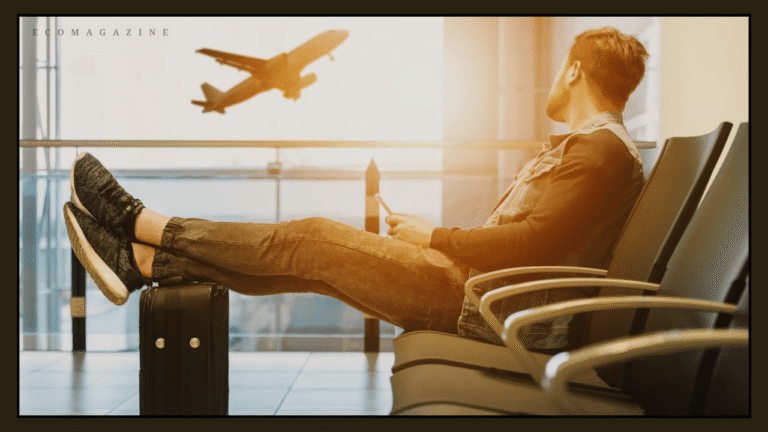Everyone may have had jet lag, that drained, foggy feeling after going through a very long flight. You’d want to avoid it as much as possible, but when the need arises, here are some science-backed habits and clever travel moves you can adopt so you land clear-headed, hydrated, and ready for what you came for.
1. Choose Your Seat With Strategy (Don’t Leave It to Chance)
Your survival actually begins before takeoff, so make seating arrangements before then. When you’re seated somewhere over the wing, you reduce feeling the turbulence; sitting by a window gives you a wall to lean on, and sitting along the aisle gives you freedom to move. And, if your flight has a mix of cabin lighting, align your seat time with your intended sleep window. You may also check how far your seat is from restrooms and galley, the less you get disturbed, the better rest you’ll have during the flight.
So, whether you’re travelling to experience extraordinary desert flights in the Gulf or explore some river trips in Asia, these flight tricks can help you maintain adventure mode even after very long trips.
2. Pre-Flight Sleep & Phase Shifting
You need to start “training” your internal clock two days before every departure, like shifting your sleep schedule closer to your flight’s arrival time by 30 to 60 minutes every day. This way, you prime your system, like setting a body clock. Some meds, like Melatonin (2–5 mg), taken at local bedtime after arrival can help reduce feelings of jet lag.
3. Pick and Click Layovers That Work
Some layovers aren’t just pain points; you can make them well-designed decisions to make your overall trip more interesting, taking your mind off the long haul. You may choose connecting flights with rhythms that let you rest, eat, and “reset” before the final leg of your journey.
Many stopovers, like if you’re flying from Melbourne, you might want to go via some famous Gulf destinations before your final stop. That’s usually where you can find cheap fares to Ahmedabad and other layover options to ease your pain points before the final leg of your journey. When you pick a stopover with the “right” gap — not too tight, not too long — it allows you to take a nap, walk, or adjust your body clock before attending to your business.
4. Hydration and Smart Fluids
Taking flights can be quite dehydrating; that’s why many experts recommend you hydrate (about 8 ounces of water) per hour during your flight. You also need to downplay alcohol and caffeine intakes, especially near your intended sleep window, since they can dehydrate and disrupt your sleep. Sipping herbal teas or electrolyte drinks may also help, but avoid sugary sodas as they can make you lose body fluids more.
5. Move, Stretch, Walk
Staying motionless during your plane ride is a disaster for your whole system. You can do some in-flight moves, like standing and walking to the galley (if safe), stretching your calves, rotating ankles, twisting shoulders, or leaning forward once in a while. All these can help activate your blood flow and posture, boosting alertness and reducing swelling.
6. Eat to Align Your Clock
Your eating time matters almost as much as what you eat. Some experts say that timing your meals and matching them to your new time zone can help reset your circadian rhythm. Also, go for light meals, like protein and veggies, and avoid heavy carbs or fatty choices to avoid digestive troubles while on the flight.
Once on solid ground, eat your first full meal at your local breakfast or lunch time (if possible). However, to avoid pushing your circadian rhythm backwards, you may need to skip or delay meals if they would fall on your “night zone” and avoid big dinners on day one.
7. Build a Comfort & Reset Kit
You may have to make your carry-on kit your battleground and bring some necessities, like:
- Eye mask + earplugs
- Compression socks
- Moisturizer, lip balm, mist spray
- Neck pillow that matches your sleep style
- Clean change of clothes
Also, if you believe an item helps you rest, use it; psychology matters, especially if you want to relieve long-haul fatigue.
8. Use a Jet Lag or Light Exposure App
Today’s modern apps, like Timeshifter, can generate customized light, sleep, and nap plans for your travel routes, including your chronotype. They can tell you when to seek or avoid light, when to take your nap, and when it’s okay to take caffeine or Melatonin. They’re like your guided protocols that outperform guesswork throughout your journeys.
Final Word
You don’t need magical fluff; it’s integrated circadian science, practical comfort, and route planning that you can craft to work together. This way, you prioritize comfort and your health so you’ll be ready to face the day’s challenges wherever you land, sans jet lag.


